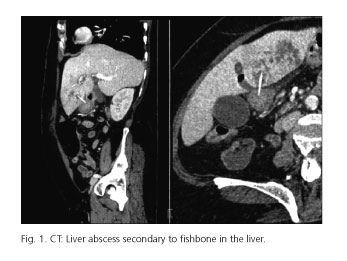My SciELO
Services on Demand
Journal
Article
Indicators
-
 Cited by SciELO
Cited by SciELO -
 Access statistics
Access statistics
Related links
-
 Cited by Google
Cited by Google -
 Similars in
SciELO
Similars in
SciELO -
 Similars in Google
Similars in Google
Share
Revista Española de Enfermedades Digestivas
Print version ISSN 1130-0108
Rev. esp. enferm. dig. vol.108 n.1 Madrid Jan. 2016
PICTURES IN DIGESTIVE PATHOLOGY
Liver abscess secondary to duodenal perforation by fishbone: Report of a case
Absceso hepático secundario a una perforación duodenal por espina de pescado: descripción de un caso
Montiel Jiménez-Fuertes, Ana Moreno-Posadas, Jaime Ruíz-Tovar and Manuel Durán-Poveda
Department of General and Digestive Surgery. Hospital Universitario Rey Juan Carlos. Móstoles, Madrid. Spain
Background
Liver abscesses usually arise from amoebian or bacterial origin, being rarely secondary to foreign bodies (1-3).
Case Report
We report the case of a 72-years-old female complaining from abdominal pain located in epigastrium and right hypochondrium during the last 48 hours. Laboratory data revealed leukocytosis with neutrophilia and pain located in the mentioned locations at physical examination. Ultrasonography showed a liver abscess involving segments 2 and 3. CT scan revealed that the abscess was secondary to a fishbone perforating the duodenum and inlaid in the liver (Fig. 1). The fishbone was surgically extracted from the hepatic lobe with hemostasia and a duodenal suture with epiploplastia was performed. Antibiotic was added to the treatment. The patient presented an uneventful postoperative course.
Discussion
The intake of foreign bodies is a frequent event, representing bones and fishbones the most frequent foreign bodies in the adults. Sometimes, the diagnosis may be difficult because the symptoms are not specific (4-6). Imaging test are very useful for the diagnosis, as in the case we present.
References
1. Masoodi I, Alsayari K, Al Mohaimeed K, et al. Fish bone migration: An unusual cause of liver abscess. BMJ Case Rep 2012; 2012. pii: bcr0920114838 DOI: 10.1136/bcr.09.2011.4838. [ Links ]
2. Matrella F, Lhuaire M, Piardi T, et al. Liver hilar abscesses secondary to gastrointestinal perforation by ingested fish bones: Surgical management of two cases. Hepatobiliary Surg Nutr 2014;3:156-62. [ Links ]
3. Motallebzadeh R, Rutter K, Jambulingam P. The case of a migratory fish bone. Clin Case Rep 2014;2:20. DOI: 10.1002/ccr3.40. [ Links ]
4. Guillén-Paredes MP, Lirón-Ruiz R, Torralba-Martínez JA, et al. Perforación intestinal por ingesta de espina de pescado. Importancia del diagnóstico por imagen. Rev Esp Enferm Dig 2010;102:569-70. [ Links ]
5. Martín Gil J, Serralta de Colsa D, García Marín A, et al. Diverticulitis yeyunal por cuerpo extraño. Rev Esp Enferm Dig 2010;102:144-5. DOI: 10.4321/S1130-01082010000200011. [ Links ]
6. Lunsford KE, Sudan R. Small bowel perforation by a clinically unsuspected fish bone: Laparoscopic treatment and review of literature. J Gastrointest Surg 2012;16:218-22. DOI: 10.1007/s11605-011-1610-y. [ Links ]











 text in
text in 


